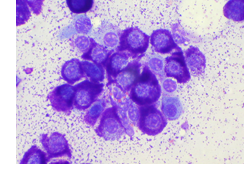
Mast cell tumours are common in dogs and account for approximately one skin tumour in every five. The Boxer is at an especially high risk as are the related breeds – English Bulldog and Boston Terrier. Also at a higher than average risk are the Shar Pei, Labrador Retriever, Golden Retriever, Schnauzer and Cocker Spaniel.
Most mast cell tumours arise in the skin although they can technically arise anywhere mast cells are found. However, the mast cell tumour does not have a characteristic appearance because of the tumour’s ability to cause swelling through the release of granules. It is not unusual for the owner to notice a sudden change in the size of the growth or, for that matter, that the growth is itchy or bothersome to the patient.
Diagnosis can often be made with a needle aspirate, which collects some cells of the tumour with a needle. The cells are then examined under a microscope. The granules have distinct staining characteristics which lead to their recognition. However, An actual tissue biopsy is needed to grade the tumour and grading of the tumour is crucial to determining prognosis.
Grade I Tumours
This is the best type of mast cell tumour to have. While it may tend to be larger and more locally invasive than may be visually apparent, it tends not to spread beyond its place in the skin. Surgery should be curative. About half of all mast cell tumours are Grade 1 tumours and can be cured with surgery alone.
Grade II Tumours
This type of tumour is somewhat unpredictable in its behaviour. These are more likely to spread to other parts of the body (metastasise) .
Grade III Tumours
This is the worst type of mast cell tumour to have. Grade III tumours account for approximately 25% of all mast cell tumours and they are very invasive and aggressive in behaviour. If only surgical excision is attempted a survival time of 6 months can be expected. This can be extended to up to 11-12 months with chemotherapy.
Anatomic Location
Mast cell tumours arising in the following areas tend to be the most malignant: nail bed, genital areas, muzzle and oral cavity. Mast cell tumours that originate in deeper tissues such as the liver or spleen carry a particularly grave prognosis.
Growth Rate of Tumours
Tumours that have been present for months or years tend to be more benign.
If you notice an unusual lump on your pet it is very important to organize a health check with Pet Doctors as soon as possible so we can start on a diagnosis if needed. Please call us on 55 760 400.

